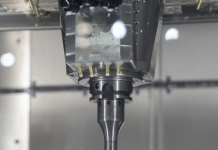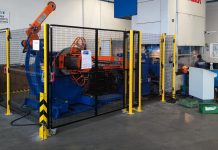A regular calibration is necessary to minimize compensation errors and scrap of all machine tools . But Too often, owners rely on simple checks with ball bars or positional lasers that just measure one major axis at a time to get an overall check of the machines accuracy. Unfortunately, these conventional devices don’t give the owner the total picture of the machine tool performance for many machines. Automated Precision Inc.is the answer.
The calibration and subsequent compensation of a medium to large, three-axis or more machine tool throughout its entire machining volume is critical for owners producing complex and accurate parts. True volumetric calibrations give owners confidence in a machine’s total accuracy throughout its entire volume and all axes, including the rotaries, and is the only way to eliminate minor angular errors other than mechanical adjustment.
History
Since the beginning of 2000, Automated Precision Inc. (API) has offered a volumetric compensation system (VCS), or volumetric error compensation (VEC) for more complex types of machiness for the volumetric compensation of machine tools. These processes, originally developed together with Boeing, Siemens, and the machine tool manufacturer Fives (formally MAG), increase the volumetric accuracy of a multi-axis machine tool by four to five times. This increase of volumetric tool-tip accuracy can also be accomplished in a single day, which is a significant savings over traditional calibration methods that could take several days. Finally, the volumetric accuracy is done right at the machine tool tip, compared to traditional calibration methods, which don’t.
Problem statement
Volumetric compensation is essentially an innovative method of assembling the volumetric map on a given machine. Up until now, a typical three-axis machine has used the traditional 21 error parameter method to measure machine-axis errors. Measurements were taken one at a time, along each individual axis, X, Y, and Z.
Each of the three axes has six error parameters: linear position, vertical and horizontal straightness, pitch, yaw, and roll. Each error parameter requires a different setup, and each required its own measurement process. In addition to these 18 error parameters, three more error parameters determine squareness of each of the X, Y, Z axes to each other, X to Y, Y to Z, and Z to X, for the total of 21 error parameters.
Even with the most sophisticated laser, this data acquisition is a long process, and roll in the Z axis must be determined by some other means. If the machine tool has additional axes, like a rotary axis, the calibration time increases rapidly.
Lastly, and in accordance with B5.54-2005, users can perform a diagonal displacement test that in theory measures the volume of the machine tool. This test is also time consuming and is still not a robust indicator of the machines volumetric accuracy.
Solution
API’s approach to the volumetric calibration solution consists of a precision laser tracker with interferometry capability. The interferometer feature of the laser tracker is the same technology traditional laser systems used for years to successfully calibrate machine tools. Coupling the interferometry technology with a laser tracker offers the added capability to track the machine’s tool-tip location through extensive axial movements throughout the entire volume of the machine.
Using the laser tracker and active target, the VEC method measures all 21 error parameters for 200–400 points within the machine’s working volume with all possible machine poses, even with the rotary axis. Each point becomes an accurate reflection of the machine’s kinematic errors. A complex algorithm is used to decouple error sources and build an extremely accurate volumetric map. Error compensation is done by adding the compensation from the entire measured axis to get the best tool-tip position.
Besides the measuring system, the API solution also includes a sophisticated proprietary calibration software that uses a polynomial equation-based, kinematic model of the machine to map errors throughout the volume. In order to compensate the machine in real time, the software resides on the machine’s controller or on an industrial computer that directly interfaces with the controller and machine tool.
In summary, the software uses the measurements from the laser tracker and active target, and develops compensation values to drastically reduce machine errors. Once the machine is put back in production, the software runs in the background, monitors the programmed toolpath, and applies real-time compensations automatically to the tool tip.
API’s VEC process
There are four steps in the VEC process for volumetric accuracy.
1. Build a 3D machine model for kinematic calculations and collision detection purposes. API provides user-friendly software that builds the 3D machine model for different types of machines. It produces a complex path for the tracker to follow in all the different setups of the machine, carefully avoiding all obstacles during the measurement process. Within the machine’s machining volume, between 200 and 400 random points are generated to represent all of the possible machine poses in each axis as the final measurement plan. The software simulation ensures these random points are collision-free and will not break the laser beam from the laser tracker to the active target located in the machine spindle during measurements. The machine model is typically generated in advance of the actual calibration event.
2. Using the measurement plan from step one, perform the actual measurement of the machine with the laser tracker and active target. The active target is held in the machines spindle by a precision fixture that allows the indexing of the target to coincide with the tool-tip position. The fixture has two positions—a long and short tool. One complete set of laser tracker measurements are taken from the long-tool position and another from the short-tool position. These measurements become the basis of the machine’s calibration and compensation. Typically, this process takes 1–2 hours.
3. Raw measurements from step two are then loaded in the API software. This is a one-button calibration and optimization process that normally takes several minutes.
4. The calibration is then validated using the output from step three and another set of measurement data from the laser tracker and active target. Once this step is validated, the machine calibration results are loaded directly into the controller for real-time compensation.
Benefits of volumetric error compensation
• Rapid calibration that minimizes compensation errors due to thermal changes over time
• Reduces machine downtime to a fraction of traditional methods
• True volumetric accuracy at all machine poses
• Real-time compensation directly from the machine controller
• Eliminates the need for rotary kinematic error calibration (e.g., Trafo 5 parameters in the Siemens controller)
• Reduced scrap from out-of-spec parts
• True understanding of the machine’s capability
Call to action
API strongly believes that periodic setup, monitoring, and calibration of the machine on a regular basis is necessary to provide you with long term Machine Tool Health (MTH). With the advancement of technologies, we now have the ability to not only correct machine movement in a single plan, but also to calibrate total machinery positioning through volumetric calibration. We highly recommend that machines are calibrated at least annually if not more often, based on run time, material removal rates, and the possible use of the machine as a CMM for validating part accuracy.



